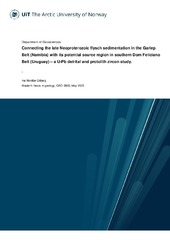Institutt for geovitenskap: Nye registreringer
Viser treff 501-520 av 1121
-
Redox fluctuations, trace metal enrichment and phosphogenesis in the ~2.0 Ga Zaonega Formation
(Journal article; Tidsskriftartikkel; Peer reviewed, 2020-03-24)The ~2.0 Ga Zaonega Formation (ZF) holds one of the oldest phosphorites in the geologic record, reaching >15% P<sub>2</sub>O<sub>5</sub>. Understanding the depositional conditions that enabled sedimentary phosphorus enrichment in this unit will thus help us to interpret the significance of the temporal distribution of phosphorites in Earth’s early history. Here we use an array of major and trace ... -
Reduced Arctic sea ice extent during the mid-Pliocene Warm Period concurrent with increased Atlantic-climate regime
(Journal article; Tidsskriftartikkel; Peer reviewed, 2020-09-01)Quantifying the contribution of poleward oceanic heat transport to the Arctic Ocean is important for making future sea ice and climate predictions. To highlight its potential importance in a warmer world, we present a new record of water-mass exchange between the Atlantic and the Arctic Oceans using the authigenic neodymium isotopic composition of marine sediments from the Fram Strait during the ... -
Salt-driven evolution of a gas hydrate reservoir in Green Canyon, Gulf of Mexico
(Journal article; Tidsskriftartikkel; Peer reviewed, 2020-09)The base of the gas hydrate stability zone (GHSZ) is a critical interface, providing a first-order estimate of gas hydrate distribution. Sensitivity to thermobaric conditions makes its prediction challenging particularly in the regions with dynamic pressure-temperature regime. In Green Canyon in the northern Gulf of Mexico (Block GC955), the seismically inferred base of the GHSZ is 450 meters (1476 ... -
Elevation changes of the Fennoscandian Ice Sheet interior during the last deglaciation
(Journal article; Tidsskriftartikkel; Peer reviewed, 2020-06-20)The dynamics of ice sheet interiors during the last deglaciation are poorly constrained, hindering evaluation of ice sheet models. We provide direct evidence of Fennoscandian Ice Sheet (FIS) interior behaviour during deglaciation through surface exposure dating. Our results demonstrate early thinning of the FIS, prior to the Younger Dryas (YD, 12.8‐11.7 ka). Interior thinning in central Norway was ... -
Multi-proxy approach to unravel methane emission history of an Arctic cold seep
(Journal article; Tidsskriftartikkel; Peer reviewed, 2020-08-13)Arctic Ocean sediments contain large amounts of methane in the form of free gas and gas hydrate. This highly dynamic methane reservoir is susceptible to be modified by bottom water warming. The warming may lead to gas hydrate destabilization releasing elevated methane fluxes to the seafloor and seawater. Reconstructing past methane dynamics can be achieved by using specific proxies left in the ... -
Connecting the late Neoproterozoic flysch sedimentation in the Gariep Belt (Namibia) with its potential source region in southern Dom Feliciano Belt (Uruguay) – a U-Pb detrital and protolith zircon study.
(Master thesis; Mastergradsoppgave, 2020-06-22)The Dom Feliciano Belt in Uruguay represents a counterpart of the Gariep Belt in Namibia and these two belts are presently considered as relics of one orogen split by the Atlantic Ocean. In this study, two presumed flysch samples from the Marmora Terrane of the Gariep Belt in Namibia, and five samples from potential source areas in the Nico Perez Terrane of the Dom Feliciano Belt in Uruguay have ... -
Late Cenozoic development of the mid-Norwegian continental margin – a study of the Naust Formation based on 3D-seismic data
(Master thesis; Mastergradsoppgave, 2020-06-15)The late Cenozoic evolution of the outer continental shelf and slope on the northern part of the mid-Norwegian margin is studied using 3D seismic data. The late Cenozoic stratigraphy is subdivided into four main seismic units: unit A (oldest) to D and correlated to the established stratigraphic framework of the Naust Formation, where the oldest unit in this study correlates to the upper part of Naust ... -
Simulated last deglaciation of the Barents Sea Ice Sheet primarily driven by oceanic conditions
(Journal article; Tidsskriftartikkel; Peer reviewed, 2020-05-19)The Barents Sea Ice Sheet was part of an interconnected complex of ice sheets, collectively referred to as the Eurasian Ice Sheet, which covered north-westernmost Europe, Russia and the Barents Sea during the Last Glacial Maximum (around 21 ky BP). Due to common geological features, the Barents Sea component of this ice complex is seen as a paleo-analogue for the present-day West Antarctic Ice Sheet. ... -
Methods for Predicting the Likelihood of Safe Fieldwork Conditions in Harsh Environments
(Journal article; Tidsskriftartikkel; Peer reviewed, 2020-07-30)Every year, numerous field teams travel to remote field locations on the Greenland ice sheet to carry out polar research, geologic exploration, and other commercial, military, strategic, and recreational activities. In this region, extreme weather can lead to decreased productivity, equipment failure, increased stress, unexpected logistical challenges, and, in the worst cases, a risk of physical ... -
Holocene precipitation seasonality in northern Svalbard: Influence of sea ice and regional ocean surface conditions
(Journal article; Tidsskriftartikkel; Peer reviewed, 2020-06-13)Arctic precipitation is predicted to increase in the coming century, due to a combination of enhanced northward atmospheric moisture transport and local surface evaporation from ice-free seas. However, large model uncertainties, limited long-term observations, and high spatiotemporal variability limit our understanding of these mechanisms, emphasizing the need for paleoclimate records of precipitation ... -
Foreløpig helse- og miljørisikovurdering av genmodifisert soyalinje MON 87769 fra Monsanto Company (EFSA/GMO/UK/2009/76). Uttalelse fra Faggruppe for genmodifiserte organismer i Vitenskapskomiteen for mattrygghet. Innspill til EFSAs GMO Extranet
(Research report; Forskningsrapport, 2011-02-18)Helse- og miljørisikovurderingen av den genmodifiserte soyalinjen MON 87769 (EFSA/GMO/UK/2009/76) fra Monsanto er utført av Faggruppe for genmodifiserte organismer i Vitenskapskomiteen for mattrygghet. Mattilsynet og Direktoratet for naturforvaltning (DN) ber Vitenskapskomiteen for mattrygghet om å vurdere den genmodifiserte soyalinjen MON 87769 til bruk i næringsmidler og fôrvarer, men ikke til ... -
Crustal processes sustain Arctic abiotic gas hydrate and fluid flow systems
(Journal article; Tidsskriftartikkel; Peer reviewed, 2020-06-30)The Svyatogor Ridge and surroundings, located on the sediment-covered western flank of the Northern Knipovich Ridge, host extensive gas hydrate and related fluid flow systems. The fluid flow system here manifests in the upper sedimentary sequence as gas hydrates and free gas, indicated by bottom simulating reflections (BSRs) and amplitude anomalies. Using 2D seismic lines and bathymetric data, we ... -
Anthropocene rockfalls travel farther than prehistoric predecessors
(Journal article; Tidsskriftartikkel; Peer reviewed, 2016-09-02)Human modification of natural landscapes has influenced surface processes in many settings on Earth. Quantitative data comparing the distribution and behavior of geologic phenomena before and after human arrival are sparse but urgently required to evaluate possible anthropogenic influences on geologic hazards. We conduct field and imagery-based mapping, statistical analysis, and numerical modeling ... -
Superimposed macro- and mesoscale folds, and their relation to ductile shear zones in the Karasjok Greenstone Belt, Finnmark, Norway
(Master thesis; Mastergradsoppgave, 2020-06-05)The Karasjok Greenstone Belt (KGB) is a N-S trending supracrustal belt in Northern Norway. The KGB may comprise economically important mineral resources. Thus, a better understanding of ore genesis and structural architecture is key information for future exploration. The purpose of this master thesis is to perform detailed structural analysis based on field work in the northern part of KGB. Field ... -
Long-lasting Cadomian magmatic activity along an active northern Gondwana margin: U–Pb zircon and Sr–Nd isotopic evidence from the Brunovistulian Domain, eastern Bohemian Massif
(Journal article; Tidsskriftartikkel; Peer reviewed, 2016-11-03)Cadomian magmatic complexes of the Brunovistulian Domain crop out at the eastern termination of the Bohemian Massif. However, the age, nature and geotectonic affinity of some of pre-Variscan (meta-)igneous rock complexes from this domain are still unknown. Geochronological and geochemical study of the granitic rocks across the Brunovistulian Domain reveals new information about the timing and nature ... -
Identifying global vs. basinal controls on Paleoproterozoic organic carbon and sulfur isotope records
(Journal article; Tidsskriftartikkel; Peer reviewed, 2020-06-03)Paleoproterozoic sedimentary successions are important archives of the redox evolution of Earth’s atmosphere and oceans. Efforts to unravel the dynamics of our planet’s early oxygenation from this archive rely on various geochemical proxies, including stable carbon and sulfur isotopes. However, ancient metasedimentary rocks often experienced early- and late-stage (bio)geochemical processes making ... -
The rock slope failures at Låvan and Dusnjarga, Northern Norway. A comprehensive Quaternary, morphological and structural analysis
(Master thesis; Mastergradsoppgave, 2020-05-15)Rock avalanches and subsequent displacement waves represented the deadliest natural disaster in Norway in the past century. The two deep-seated and unstable slopes Dusnjarga and Låvan in Troms county (Norway) are clearly defined by morphological deformation features. Due to the steep fjord setting, a potential catastrophic rock avalanche could pose a severe threat to people and infrastructure along ... -
Modification of bedrock surfaces by glacial abrasion and quarrying: Evidence from North Wales
(Journal article; Tidsskriftartikkel; Peer reviewed, 2020-05-30)Abrasion and quarrying are significant processes of subglacial erosion for ice masses in direct contact with hard substrates, yet their relative efficacy and spatio-temporal variability is unclear. Here, we investigate the glacial impact of these processes on a 70 m by 60 m bedrock surface at Moel Ysgyfarnogod in the Rhinog Mountains, Wales, using a combination of high-resolution digital photographs, ... -
Upper Triassic to lower Cretaceous tectonostratigraphic development of the Barents Sea South East
(Master thesis; Mastergradsoppgave, 2020-05-27)The aim of this study is to investigate the tectonic- and evolutionary differences between major structural elements of the Barents Sea South East (BSSE) during the uppermost Triassic to lower Cretaceous. The study area comprises the following structural elements: the Bjarmeland- and Finnmark platforms, the Nordkapp- and Tiddlybanken basins, the Signalhorn-, Haapet- and Veslekari domes and the ... -
Tempestite facies variability and storm‐depositional processes across a wide ramp: Towards a polygenetic model for hummocky cross‐stratification
(Journal article; Tidsskriftartikkel; Peer reviewed, 2019-10-03)The hydrodynamic mechanisms responsible for the genesis and facies variability of shallow‐marine sandstone storm deposits (tempestites) have been intensely debated, with particular focus on hummocky cross‐stratification. Despite being ubiquitously utilized as diagnostic elements of high‐energy storm events, the full formative process spectrum of tempestites and hummocky cross‐stratification is still ...


 English
English norsk
norsk


















